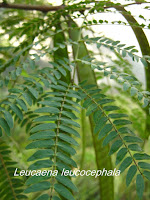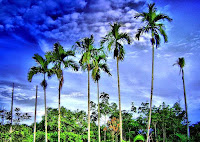Ongzi, a zeal HORTICULTURIST,yet resides in a plant-free apartment…… thinks that plants deserved to be treated as LIVING THING, not merely as plants …… strongly condemns any form of CRUELTY TO PLANTS, yet enjoys feast on them…… collects only e-HERBARIUM, and proudly encourages others to do the same……
Thursday, 9 June 2011
Knapsack Sprayer
A sprayer is an equipment used to apply liquid herbicides, insecticides and fertilizers, etc. In agriculture, sprayer range in size from man-portable units, motorized to tractor-mounted. A knapsack sprayer is such device carried strapped on the back or shoulder of an applicator.
Knapsack sprayer works on pressurized air. Air is forced into the air-tight sprayer, then the liquid is released through a spray gun, via a nozzle which facilitate dispersion the liquid.
There are various type of knapsack sprayer, depending on their capacity : 20 liter, 16 liter, 12 liter, 10 liter, 9 liter etc.
Wednesday, 8 June 2011
Coccinia grandis
Cute’cumber is the name I called this small cute cucumber. It is about 5cm in length, only a mere 1-fifth of normal cucumber ( Cucumis sativus ). Despite its miniature size, it looks almost like a cucumber, tastes just as similar.
Cute’cumber , is in fact a not-so-far relative of cucumber. They are of the same subfamily of Cucurbitoideae, of the family of Cucurbitaceae. Cucumber is from the Melothrieae tribe ; while cute’cumber is from the Benincaseae tribe, together with watermelon.
It is a native of wide range of Asia. In India, it is known as tindora, and many other names, varied from various dialects and languages. In English, it is called Ivy gourd. Botanically, it is known as Coccinia grandis, synonym Cephalandra indica.
C. grandis is a dioecious perennial herbaceous vine. Stem glabrous. Tendrils simple, axillary. Leaves alternate, simple, 5-lobed, 3-8 glands near the base. Inflorescence solitary, white corolla, 5-lobes, 3 stamens, inferior ovary with 5-lobes. Fruit a berry, smooth, green, red when ripened.
C. grandis is considered a weed in Hawaii, and some other places.
In India, and S.E.Asia, its young shoots and fruits are consumed as greens.
Young leaves and shoots are cooked and eaten as veg.
Green mature fruits are eaten fresh in salad, or stir-fried, or cooked in curries.
Ripened fruit is eaten raw.
It contains polyprenol ( C0-polyprenol (1) ) which is anti-inflammatory, antioxidant, antimutagenic, antidiabetic, antibacterial, antiprotozoal, antiulcer, hepatoprotective, expactorants, analgesis, antiinflamatory.
It is also a god source of several micronutrients, vitamins A and C.
Friday, 3 June 2011
Leucaena leucocephala - Petai Belalang
Leucaena leucocephala (Lam.) De wit is a tropical species of small tree native to South America. It is known as petai belalang in Malay language. In Indonesia, it is known as lamtoro.
The specific name is derived from Greek word λευκό which means “white” ; and κέφαλος which means “head”, in allusion to its flowers.
Symnonyms : Acacia leucocephala (Lamark) Link 1822, Leucaena glabrata Rose 1897, Leucaena glauca (L.) Benth 1842, Mimosa leucocephala Lamark 1783
There are 3 subspecies : subsp. leucocephala, subsp. glabrata, and subsp. ixtahuacana.
L. leucocephala can grow up to 20 meter in height.
The leaves are bipinnate. Leaflets are 9-16mm long and 2-4mm wide.
Flowers are actinomorphic, about 12-21mm diameter, cream white colour, 10 free stamens per flower, hairy anthers.
Pod occure in cluster of 5-20 per flower head, 11-19cm long, 15-21mm wide, flattened, 8-18 seeds per pod, dehiscent.
Pollination via insects, self-fertile.
Trees are generally short-lived ( 20-40 years )
It can grow in wide range of habitats : coastal, riverine, semi-natural, ex-mining, disturbed sites etc
L. leucocephala is susceptible to the psyllid Heteropsylla cubana, which cause serios defoliation and mortality.
Ganoderma lucidum causes root rot.
L. leucocephala is efficient in nitrogen fixation, at more than 500kg/ha/year.
The leaves are highly nutritious for ruminants.
 The wood is used as firewood, and produced into charcoal. It can also be used for parquet flooring, furniture, as well as paper pulp. Straight trunk is used as posts.
The wood is used as firewood, and produced into charcoal. It can also be used for parquet flooring, furniture, as well as paper pulp. Straight trunk is used as posts.
L. leucocephala thickets are used as windbreeakers and firebreakers.
The young seeds and young leaves are consumed as vegetables.
In Indonesia, ‘tempe lamtoro’ is made of fermented leucaena seeds.
The leaves and seeds contain mimosine, a toxic to non-ruminant vertebrates, thus not advisable to consume in large quantity.
Mimosine is broken down in the rumen to DHP ( 3-hydroxy-4-(1H)-pyridone ), which is further broken down by rumen microorganisms to non-toxic compounds.
Reference
Thursday, 2 June 2011
National & State Flowers of Malaysia
National flower
Malaysia – Hibiscus rosa-sinensis ( Bunga raya )
State flowers
Johor – n.a.
There is no state flower assigned to the state of Johor.
However, in Johor’s coat of arms, the mirrored flora represents gambir ( Uncaria gambir ) and black pepper ( piper nigrum ), once an important crops cultivated in Johor.
Kedah – n.a.
There is no state flower assigned to the state of Kedah.
The wreath in the Kedah’s coat of arms, is depicted as two stalks of rice ( Oryza sativa ) together, and enveloping the shield and crescent. It represents rice as the state principal product.
Kelantan – n.a.
There is no state flower assigned to the state of Kelantan.
Melaka - Vallabris Glabra ( kesidang )
In Melaka’s coat of arms, a Melaka tree ( Phyllanthus emblica ) is depicted in the middle of the shield, of which the state derives its name. It is also under the Melaka tree of which Parameswara rested, and decided to found the kingdom of Melaka.
Negeri Sembilan – n.a.
In Negeri Sembilan’s coat of arms, nine stalk of rice ( Oryza sativa ) s depicted in the middle of the shield. The nine stalks signifies the nine states under the old Negeri Sembilan.
Pahang – n.a
There is not state flower assigned to the state of Pahang.
There is not state flower assigned to the state of Pahang.
Perak – n.a.
The coat of arms of Perak is circled with a crescent that contains flowers of rice ( Oryza sativa ) of which the flowers of rice reflects the source of income for Perak.
Perak Tourist Association is proposing Kinta weed orchid ( Vanda hookeriana ) as Perak’s state flower.
Perlis – n.a.
There is no state flower assigned to the state of Perlis.
In Perlis' coat of arms, a wreath is depicted surrounding the shield. The wreath illustrated as a pair of green untied rice stalks ( Oryza sativa ) that nearly envelope the shield. The wreath signifies the cultivation of rice as the state’s main product and a major source of its economic activities. The yellow wreath within the arm’s shield carry the same symbolization.
Pulau Pinang – n.a.
There is no state flower assigned to the state of Pulau Pinang.
At the top of Pulau Pinang's coat of arms is a betel nut palm ( Areca catechu ) of which the state derives its name.
Eusideroxylon zwaggen, of which the timber are harvested for its Belian wood, is the official state tree.
Semah fish ( Tor douronensis ), nicknamed 'swimming goldmine' is the official state fish.
Selangor – Mimusop elengi ( bunga tanjung )
Wednesday, 1 June 2011
Landscape : Curbing The Curbs
Road curb or kerb, is the edge where a raised footpath, road median or road shoulder meets an unraised roadway. It is typically made from concrete, asphalt or long stones.
Ideally …
Curbs are designed to guide water from melted snow and rain into storm drains. It also keeps vehicles on the road. Curbs also add to the aesthetic aspect of the road.
Since curbs add to the cost of a road, they are generally limited to urban and suburban areas, except where certain drainage conditions make them necessary. However, curbs are not universally used, even in urban settings.
In reality …
Poorly maintained curbs often results in ponding of water. Sand and dirt from vehicles, blades of grass leaves, debris and rubbish accumulate at drain. After some time, the sand and debris become growing bed for weeds. Soon the curb will be infested with weeds of all sizes !
Often after heavy downpour, surface rainwater find limited outlet to drain out of the road. The curbs acts as a retention wall to keep the water in, while the scupper drains hardly suffice to drain the water in time ( as diagram below ). It is not hard to find Malaysian roads flooded during heavy downpours, no thank to curbs !
Big puddles can be dangerous, as they can cause hydroplaning at higher speeds and loss of control of a vehicle. At times, water can spray from tires onto following vehicles, causing poor visibility. Also the unfortunate are pedestrians and motorcyclists who were splashed by hydroplaning.
Prolonged ponding due to blocking of water by curbs eventually leads to deterioration of asphalt concrete roads. Over time, the damaged asphalt widened and deepened. Potholes posses danger to motorists, especially motorcyclists, the least, damage the vehicle's tires and suspension system.
At the end of the day, all the shortcomings and damages translate into monetary losses. Additional cost to construct the curbs, extra earth to level up, sweeping of sands, rubbish collection, weeding etc… all at our expense, the ratepayers. For sure, someone is making a profit out of it.
To consider …
There are no doubts that curbs do serve their purpose, providing there are rightly located. There are places for them, there are places not for them as well.
While it may be feasible to have curbs at pedestrian-heavy urban and housing estates, it may not necessary for highways, trunk roads and any other road with low pedestrian users.
While it may be feasible to have curbs at pedestrian-heavy urban and housing estates, it may not necessary for highways, trunk roads and any other road with low pedestrian users.
Cambered asphaltic concreted road, tufted soil/walkway should be leveled to allow smooth flow of water into the storm drains ( as diagram above ). It may seems inconvenience for pedestrian as the water from the road, flowing pass the walkway. But who would walk down less-travelled road during heavy downpour ?
Subscribe to:
Comments (Atom)


























